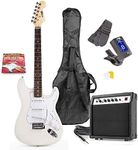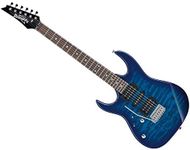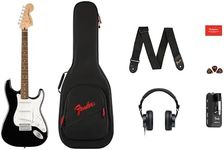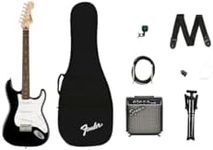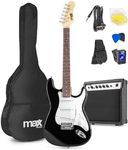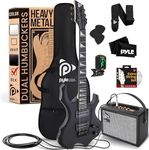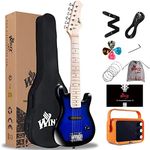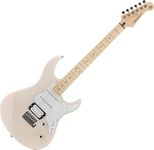Buying Guide for the Best Kid Electric Guitar
Choosing the right kid electric guitar can be a fun and rewarding experience. It's important to find a guitar that not only fits your child's size and skill level but also inspires them to play and learn. When selecting a guitar, consider factors such as the size of the guitar, the type of music your child is interested in, and the features that will make playing easier and more enjoyable for them. Remember, the goal is to encourage a love for music, so choose a guitar that your child will be excited to play.SizeThe size of the guitar is crucial for a child, as it affects their ability to play comfortably. Guitars come in various sizes, typically ranging from 1/4, 1/2, 3/4, to full size. A smaller guitar is easier for a child to handle, especially if they are younger or smaller in stature. For children under 8, a 1/4 or 1/2 size guitar is often recommended. For those between 8 and 12, a 3/4 size might be more appropriate. Older children or those with larger hands might be ready for a full-size guitar. Choosing the right size ensures that your child can reach the frets and strum comfortably, which is essential for learning and enjoying the instrument.
WeightThe weight of the guitar is another important factor, as a heavy guitar can be difficult for a child to hold and play for extended periods. Electric guitars can vary in weight depending on the materials used and the design. Lighter guitars are generally more suitable for younger children, as they are easier to manage and less likely to cause fatigue or discomfort. When selecting a guitar, consider your child's strength and stamina, and opt for a model that they can comfortably hold and play.
Neck ProfileThe neck profile refers to the shape and thickness of the guitar's neck, which can affect playability. A thinner neck is often easier for children to grip, especially if they have smaller hands. Common neck profiles include C-shaped, U-shaped, and V-shaped, with the C-shape being the most versatile and comfortable for beginners. When choosing a neck profile, consider your child's hand size and comfort level. A neck that feels comfortable in their hand will make it easier for them to learn chords and scales.
PickupsPickups are the components that capture the sound of the strings and convert it into an electrical signal. They play a significant role in the guitar's tone. There are two main types of pickups: single-coil and humbucker. Single-coil pickups offer a bright, clear sound, while humbuckers provide a thicker, warmer tone. If your child is interested in rock or metal music, humbuckers might be more suitable. For pop or blues, single-coils could be a better fit. Consider the type of music your child wants to play when selecting pickups, as this will influence the sound they can achieve.
Body ShapeThe body shape of an electric guitar can affect both the sound and the comfort of playing. Common shapes include Stratocaster, Telecaster, and Les Paul, each offering different tonal qualities and aesthetics. A Stratocaster shape is often lightweight and versatile, making it a popular choice for beginners. The Les Paul shape is heavier but offers a rich, full sound. Consider your child's musical preferences and comfort when choosing a body shape. A guitar that feels good to hold and play will encourage more practice and enjoyment.
String GaugeString gauge refers to the thickness of the guitar strings, which can impact playability and tone. Lighter gauge strings are easier to press down and bend, making them ideal for beginners and young players. Heavier gauge strings produce a fuller sound but require more finger strength. For a child just starting out, lighter strings (such as .009 or .010) are recommended, as they are easier on the fingers and help build confidence. As your child progresses, they can experiment with different gauges to find their preferred sound and feel.


